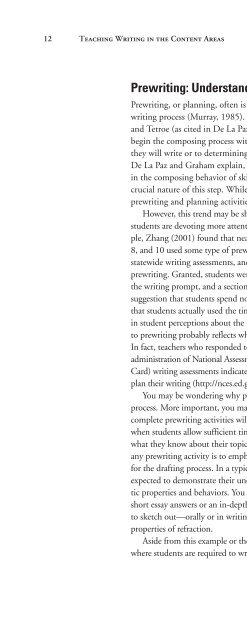How to Use It - ymerleksi - home
How to Use It - ymerleksi - home
How to Use It - ymerleksi - home
You also want an ePaper? Increase the reach of your titles
YUMPU automatically turns print PDFs into web optimized ePapers that Google loves.
12 Teaching Writing in the Content AreasPrewriting: Understanding What the Writer KnowsPrewriting, or planning, often is a neglected and underestimated step in thewriting process (Murray, 1985). In the early 1980s, Burtis, Bereiter, Scardamalia,and Tetroe (as cited in De La Paz & Graham, 2002) found that students oftenbegin the composing process with little <strong>to</strong> no time devoted <strong>to</strong> planning whatthey will write or <strong>to</strong> determining what they know about their <strong>to</strong>pic. Yet, asDe La Paz and Graham explain, “high levels of planning are especially apparentin the composing behavior of skilled writers,” (p. 687) and this highlights thecrucial nature of this step. While proficient writers exhibit extensive use ofprewriting and planning activities, novice or developing writers do not.<strong>How</strong>ever, this trend may be shifting. Current research in writing suggests thatstudents are devoting more attention and time <strong>to</strong> prewriting activities. For example,Zhang (2001) found that nearly 100 percent of Delaware students in grades 5,8, and 10 used some type of prewriting strategy in the course of completing theirstatewide writing assessments, and 77 percent of the 3rd graders spent timeprewriting. Granted, students were given questions <strong>to</strong> spark their thinking aboutthe writing prompt, and a section of the test was devoted <strong>to</strong> prewriting, with thesuggestion that students spend no more than 20 minutes planning. But the factthat students actually used the time <strong>to</strong> plan their compositions may signal a changein student perceptions about the importance of prewriting. This greater attention<strong>to</strong> prewriting probably reflects what students encounter in their academic classes.In fact, teachers who responded <strong>to</strong> survey questions during the 1998 and 2002administration of National Assessment of Educational Progress (the Nation’s ReportCard) writing assessments indicated that they almost always asked their students <strong>to</strong>plan their writing (http://nces.ed.gov/nationsreportcard/naepdata/search.asp).You may be wondering why prewriting is such an important step in the writingprocess. More important, you may not see how making the time for students <strong>to</strong>complete prewriting activities will support your content-area instruction. For one,when students allow sufficient time for prewriting, it enables them <strong>to</strong> understandwhat they know about their <strong>to</strong>pic (Lindemann, 1995). In fact, the ultimate goal ofany prewriting activity is <strong>to</strong> emphasize what students know and <strong>to</strong> prepare themfor the drafting process. In a typical 8th-grade science class, students might beexpected <strong>to</strong> demonstrate their understanding of waves, including their characteristicproperties and behaviors. You may decide <strong>to</strong> assess this knowledge throughshort essay answers or an in-depth research report. Prewriting allows your students<strong>to</strong> sketch out—orally or in writing—what they know about wavelengths or theproperties of refraction.Aside from this example or the typical high-stakes assessment environmentwhere students are required <strong>to</strong> write on demand, one recognizes that prewriting
















